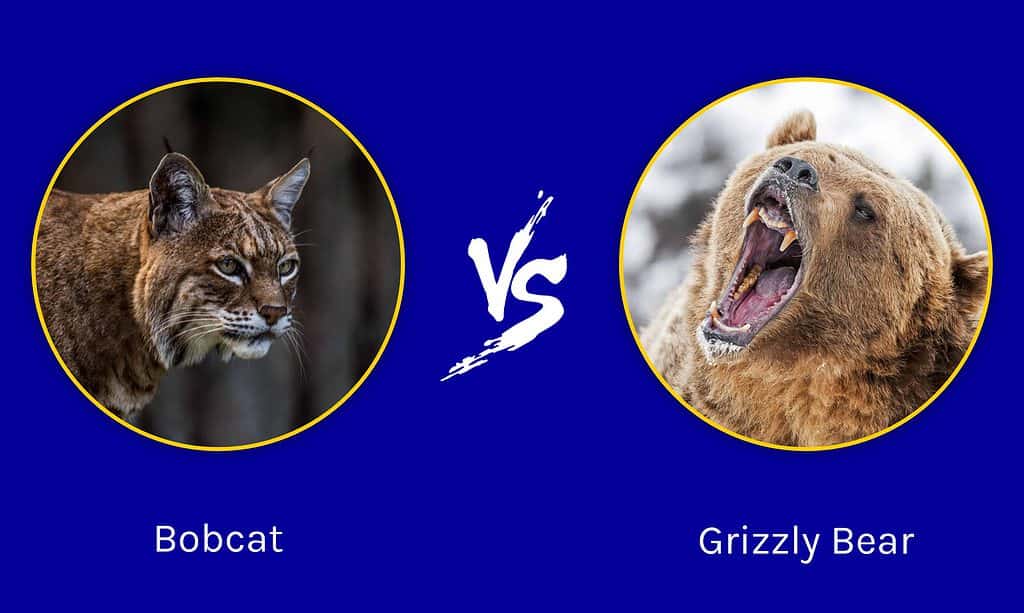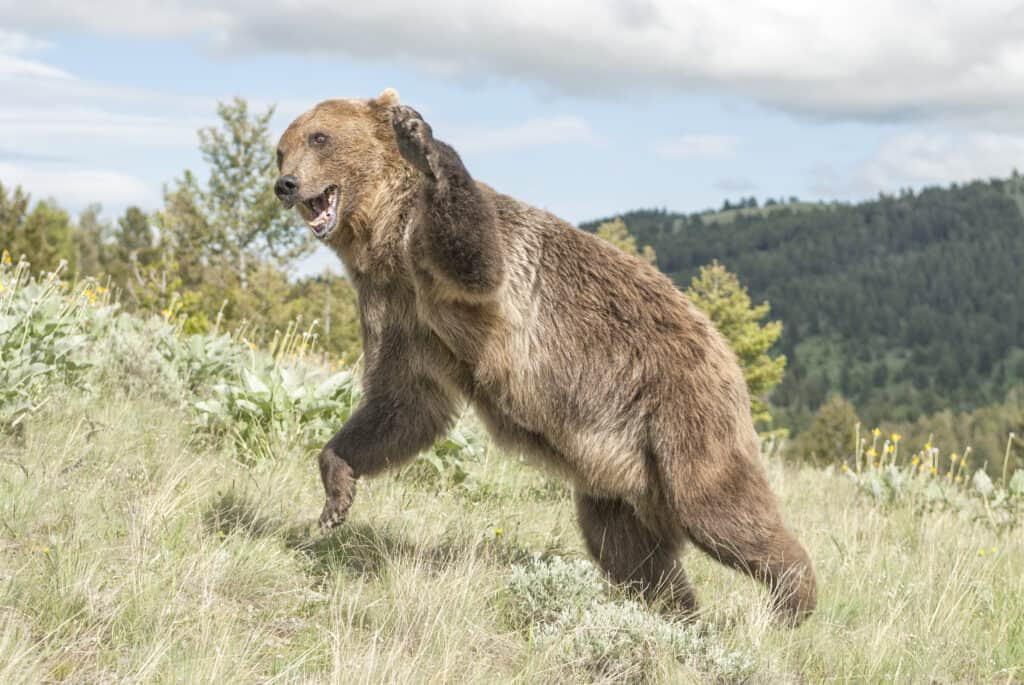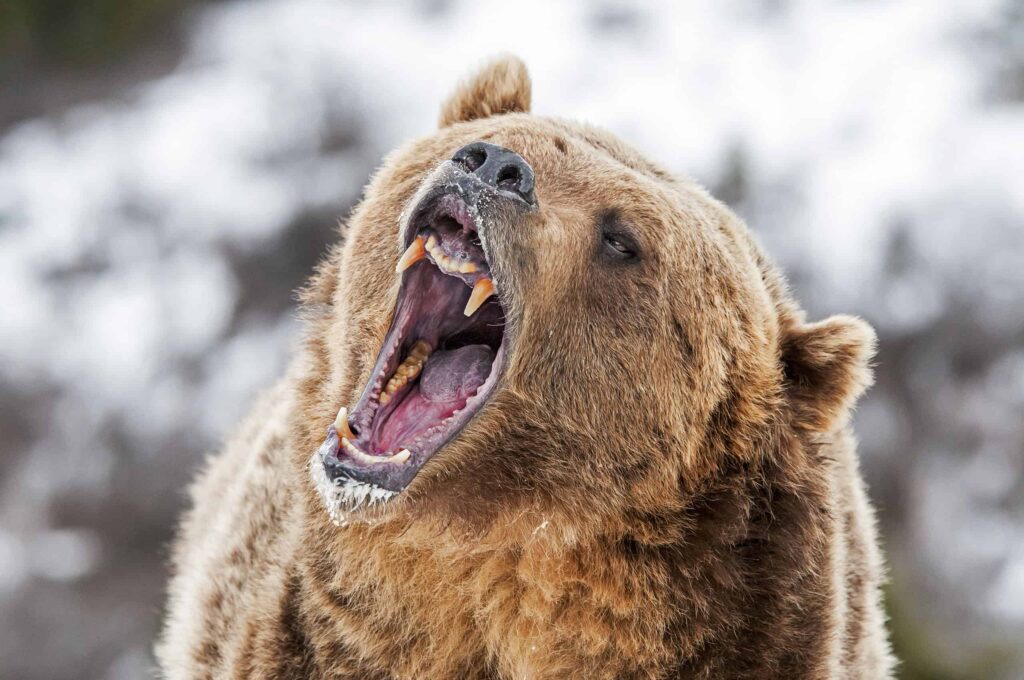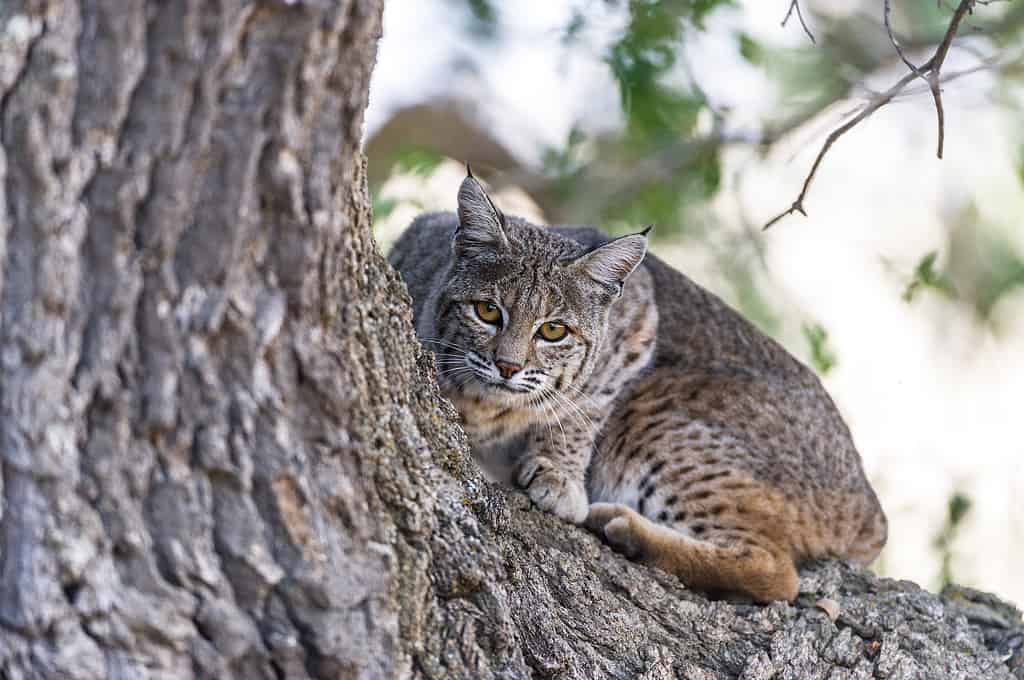Grizzly bears are some of the deadliest animals in North America. They can take down creatures as large as elk and moose! Still, we have to wonder what would happen if we put the grizzly bear at a disadvantage in terms of numbers. Instead of a fight against a lone bobcat, we want to know how a fight between 5 bobcats vs a grizzly bear would go.
We’ll break down this battle between the six combatants and show you which animal or animals walk away from this fight alive and why that’s the case!
Comparing a Bobcat and a Grizzly Bear

| Bobcat | Grizzly Bear | |
|---|---|---|
| Size | Weight: 8 to 33 pounds Length: 1.5 to 4.1 feet long Height: 1.5 to 2 feet tall at the shoulder | Weight: average 400 to 700 pounds but large bears weigh over 1,000 pounds Height: between 3 and 4 feet at the shoulder Length: grow from 7 to 10 feet long |
| Speed | – up to 34 mph | – Reach maximum speeds between 35 and 40 mph |
| Defenses | – Has high speed and agility – Excellent senses to spot danger – Can climb trees and other vertical areas to stay safe from predators – Scary threat display | – Their incredible strength makes it hard to take down a grizzly bear – Vital areas protected by fur, thick skin, and a layer of fat that measures several inches thick |
| Offensive Capabilities | – Powerful bite force for their size – Teeth roughly 1 inch in length – Sharp and retractable claws can scratch eyes | – Claws that measure between 3 and 5 inches can be used to slash foes – Have canine teeth that measure up to 3 inches long – Bite power of 975 PSI, enough to break through bones – Massive paws and power to smack prey |
| Predatory Behavior | – Ambush predator that stalks its prey and tries to sneak up for a deadly bite to the neck | – Uses elements of ambush attacks and cursorial predation – Usually, they maul their prey to death |
What Are the Key Differences Between 5 Bobcats and a Grizzly Bear?
The most significant differences between five bobcats and a grizzly bear can be found in their size and hunting methods. The average grizzly bear is an ambush and cursorial predator that weighs between 400 and 700 pounds and stands between 3 and 4 feet tall at the shoulder while measuring between 7 and 10 feet long. Meanwhile, bobcats are ambush predators that weigh between 8 and 33 pounds, grow between 1.5 and 4.1 feet long, and stand between 1.5 and 2 feet tall at the shoulder!
While these differences are large, they are just two elements of the fight. We need to examine many other factors to figure out how this battle would end.
What Are the Key Factors in a Fight Between 5 Bobcats and a Grizzly Bear?
Like most other battles between two animals, this fight comes down to five factors. Specifically, we need to look at each animal’s size, speed, offenses, defenses, and predatory methods. By comparing these data points for each animal, we can determine which creature has an advantage or a disadvantage in the fights.
After we have finished going through each factor, we’ll apply the data to 5 bobcats and weigh it against a grizzly bear. Then, we’ll use facts about each animal and a little imagination to determine which animal would win this fight! So, let’s get to it!
Bobcat vs. Grizzly Bear: Size

Five bobcats cannot match the size of a grizzly bear.
©Jack Nevitt/Shutterstock.com
A grizzly bear is larger than a bobcat or even all five of the bobcats taking part in this fight. The average grizzly bear weighs between 400 and 700 pounds, but some of them have weighed over 1,000 pounds! Meanwhile, bobcats are medium-sized predators that weigh between 8 and 33 pounds.
Grizzly bears stand between 3 and 4 feet tall and measure between 7 and 10 feet long at their largest. Meanwhile, bobcats measure about 1.5 to 4.1 feet long and stand up to 2 feet tall at the shoulder.
Needless to say, the grizzly bear has a significant size advantage in this battle.
Bobcat vs. Grizzly Bear: Speed

Bobcats are quick and agile.
©iStock.com/twildlife
Although bobcats are quick and agile, they’re not as fast on the ground as a grizzly bear. That may be surprising, but the fact is that bobcats top out at about 34 mph while running. Yet, a grizzly bear can reach top speeds of somewhere between 35 and 40 mph while chasing down its prey.
Grizzly bears may not be as agile, but they have the speed they need to hunt prey or get away from danger, and they have the advantage here.
Bobcat vs. Grizzly Bear: Defenses
A lot of animal battles come down to how much damage animals can withstand before keeling over. In this case, the grizzly bear is going to be better off than the bobcat. These massive beasts have large bodies, indomitable strength, and a mix of fur, thick skin, and a layer of fat to protect them from bites, cuts, and blunt attacks. Some grizzly bears have shrugged off gunfire!
Bobcats are like other small felines. They don’t have much in the way of protection aside from their fierce nature, threat display, and speed to escape from predators. In this case, though, the bobcat is not as fast as a grizzly bear.
Some people believe that grizzly bears couldn’t follow a bobcat up a tree, but that’s not entirely true. While they can’t climb as fast as bobcats or on smaller trees, grizzly bears can climb! They could pursue a bobcat up a tree in some cases.
Grizzly bears have an advantage in defensive prowess!
Bobcat vs. Grizzly Bear: Offensive Capabilities

Grizzly bears have powerful bite force.
©outdoorsman/Shutterstock.com
Bobcats have two methods of attack. They can either use their teeth that measure about 1 inch long to deliver a bite more powerful than their size suggests, or they can use their small, sharp, retractable claws to slash their prey. These tools are formidable, even against animals that are bigger than them.
Yet, a grizzly bear has even more powerful ways of attacking other animals. Their claws measure between 3 and 5 inches long. While they’re not particularly sharp, they can still gash foes. Also, the paws from which the claws erupt are very large, and they can use their immense power to smack other animals around.
Grizzly bears have large canine teeth that are about 3 inches long, and they have a bite force that can reach almost 1,000 PSI! That allows them to bite into vulnerable parts of their prey’s body and do significant, often fatal damage.
Grizzly bears have an offensive advantage for their more diverse toolkit and power.
Bobcat vs. Grizzly Bear: Predatory Behavior
Averagely, bobcats are ambush predators that hunt small mammals and kill them for food. They stalk their prey and then leap forward from their hiding spot to bite it on the neck and end the fight in moments.
Grizzly bears somewhat rarely act as predators, preferring to find their food or scavenge it. When they do hunt, they use a mix of ambushing tactics to get the drop on their prey, often stalking it before using a burst of speed to catch it and bring it down. With larger prey, they engage in almost cursorial hunting, chasing the prey, injuring it, and finally taking it down when it’s too tired to fight back.
Who Would Win in a Fight Between 5 Bobcats and a Grizzly Bear?

A grizzly bear would win the battle against five bobcats effortlessly.
©Scott E Read/Shutterstock.com
A grizzly bear would beat 5 bobcats in a fight. The reason is quite simple: bobcats are just too small and weak to damage a grizzly bear. Their small teeth and claws simply cannot do enough damage to cause a grizzly bear to die or flee.
By presenting themselves to the grizzly bear to fight, since they would probably try an ambush attack if they were inclined to work together, they are merely saving the grizzly the time it would take to hunt them down individually. Bobcats are fast and agile, so the grizzly has its work cut out for it in terms of catching each one.
As its large body soaks the scratches and bites from these creatures, the grizzly will become more and more furious, using its weight, mauling techniques, and deceptive speed to grab the closest, most vulnerable attacker.
All told, five bobcats are not enough to overwhelm the grizzly bear with their power and weight. They can’t drag it down, and they can’t inflict deadly wounds. The grizzly bear may be outnumbered, but it would quickly pick its way through the pack until they are dead or flee from the battle. Either way, the grizzly bear wins the fight. Top of Form
Could a Grizzly Bring Down a Pack of Wolves?
Obviously, a single grizzly would easily kill a single wolf due to the huge difference in size. But, since we have been discussing a group of bobcats going against a single bear, how would a pack of wolves do against one massive grizzly? Wolves hunt in packs and share a range of territories with grizzlies – so this could really happen!
The largest grizzly can weigh up to 1,000 pounds – but what about a pack of wolves? Timberwolves or gray wolves are the most common in the grizzly territory, and they weigh between 70 and 150 pounds each and run in packs of up to 20. So, let’s put a pack of ten timber wolves at 100 pounds each against an extra large grizzly of 1,000 pounds.
Both animals are highly intelligent and both are apex predators but bears aren’t known for strategy. They simply overpower their prey – as simple as that! Wolves, however, are known to set traps and ambushes. A wolf will get a pet dog to chase it far enough away for the rest of the pack to come out of hiding, surround it and kill it.
The bite force is always a factor in these epic battles – and we know that grizzlies bite with a powerful force of nearly 1,000 PSI. Wolves have a bite force of around 500 PSI – not too shabby! Grizzlies have massive arms and paws sporting sharp, 4-inch long claws that could rip through the wolf pack. But the wolves would be coming at the bear from all sides – ten powerful sets of terrible teeth with a lot of bite force.
Every time the grizzly claws met a wolf – the wolf would be critically wounded if not killed. Even if the wolves kept up their attack through exhaustion and dismay – the very angry grizz would just keep picking them off. Eventually, there would be one furious, worn-out bear in the middle of ten carcasses. Even a whole pack of hungry wolves is no match for one big grizzly!
Bonus: Do Bobcats Attack Humans?

It’s very rare for a
bobcat
to attack a human, but they will prey on small, unattended pets if given the chance.
©iStock.com/brentawp
Most people are very aware of the danger that a grizzly bear poses to a human, as they are fully capable of overpowering and killing those unfortunate folks who have encountered them in the wild. These ferocious animals are responsible for about 44 attacks annually worldwide, though there are few fatalities overall. But how about bobcats? Do bobcats pose a similar threat to humans? How often do they attack, and are they as dangerous as grizzly bears?
Bobcats (also called lynxes) are one of the smallest types of wildcats, typically weighing between 15 to 40 lbs. Sometimes bobcats are comparable in size to larger domestic cats, weighing up to 20 lbs. Due to their size, they feed on smaller prey like rabbits, birds, squirrels, rats, and chickens. They would not likely view a large human in terms of a potential meal. However, they can be drawn to yards by unattended small pets, which are attractive prey to bobcats.
Other things that can attract bobcats to your property include:
- Bird baths
- Pools
- Fountains
- Water for livestock
- Food for livestock
- Space underneath decks
- Thick brush and shade
- Unoccupied yards to sunbathe in
Bobcats usually run away from a human. If you encounter one, the best thing to do is face the bobcat, stand your ground (don’t flee), and make noise. Do not, however, purposefully approach a bobcat. If a bobcat boldly approaches you, it may have rabies. While reports of bobcat attacks on humans hardly exist, there was a resident of Saddlebrooke, Arizona, who suffered a bobcat attack. Authorities believed it to be rabid, but it was not successfully captured to prove as much. The man bitten was forced to undergo a full round of rabies treatments to protect him from potential infection.
In summation, bobcats do not pose a serious threat to humans. As long as you react appropriately if an encounter with a bobcat occurs, you’ll likely walk away unscathed.
The photo featured at the top of this post is © Scott E Read/Shutterstock.com
Sources
- National Wildlife Federation, Available here: https://www.nwf.org/Educational-Resources/Wildlife-Guide/Mammals/Grizzly-Bear
- U.S. Fish & Wildlife Service (1970) fws.gov/species/grizzly-bear-ursus-arctos-horribilis
Thank you for reading! Have some feedback for us? Contact the AZ Animals editorial team.







